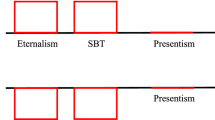
Overview
- Provides a characterization of the asymmetry between the ‘open future’ and the ‘fixed past’ in ontological terms
- Offers intuitive and essential redefinitions of the various A-theories of time in geometric terms
- Includes in-depth discussions on how things exist in the past
- This book is open access, which means that you have free and unlimited access
Part of the book series: Synthese Library (SYLI, volume 468)
Buy print copy
Tax calculation will be finalised at checkout
About this book
This open access monograph offers a detailed study and a systematic defense of a key intuition we typically have, as human beings, with respect to the nature of time: the intuition that the future is open, whereas the past is fixed. For example, whereas it seems unsettled whether there will be a fourth world war, it is settled that there was a first world war.
The book contributes, in particular, three major and original insights. First, it provides a coherent, non-metaphorical, and metaphysically illuminating elucidation of the intuition. Second, it determines which model of the temporal structure of the world is most appropriate to accommodate the intuition, and settles on a specific version of the Growing Block Theory of time (GBT). Third, it puts forward a naturalistic foundation for GBT, by exploiting recent results of our best physics (viz. General Relativity, Quantum Mechanics, and Quantum Gravity).
Three main challenges are addressed: the dismissal of temporal asymmetries as non-fundamental phenomena only (e.g., thermodynamic or causal phenomena), the epistemic objection against GBT, and the apparent tension between GBT and relativistic physics. It is argued that the asymmetry between the open future and the fixed past must be grounded in the temporal structure of the world, and that this is neither precluded by our epistemic device, nor by the latest approaches to Quantum Gravity (e.g., the Causal Set Theory).Aiming at reconciling time as we find it in ordinary experience and time as physics describes it, this innovative book will raise the interest of both academic researchers and graduate students working on the philosophy of time. More generally, it presents contents of interest for all metaphysicians and non-dogmatic philosophers of physics.
This is an open access book.
Similar content being viewed by others
Keywords
Table of contents (5 chapters)
Authors and Affiliations
About the author
Vincent Grandjean is a postdoc researcher at the Faculty of Philosophy of the University of Oxford, with a SNSF Postdoc.Mobility Fellowship. He also works as a lecturer at the Institute of Philosophy of the University of Neuchâtel, where he has taught on a variety of topics (e.g., logic, philosophy of time, paradoxes, personal identity, ethics).
Vincent Grandjean received his BA in philosophy and history (Excellence Award), and his MA in philosophy and comparative history (Werner Günter Award) from the University of Neuchâtel. As a student of the École Normale Supérieure of Paris (international selection), he also obtained the diploma of the ENS and a second MA in contemporary philosophy from the École des Hautes Études en Sciences Sociales. In April 2021, he received his PhD in philosophy (High honours, with unanimous jury congratulations) from the University of Geneva for his dissertation ‘The Asymmetric Nature of Time’.
Vincent Grandjean haspublished articles in various peer-reviewed journals (e.g., Philosophia (2022), Synthese (2012a, 2021b), and Minds and Machines (2021c).
Bibliographic Information
Book Title: The Asymmetric Nature of Time
Book Subtitle: Accounting for the Open Future and the Fixed Past
Authors: Vincent Grandjean
Series Title: Synthese Library
DOI: https://doi.org/10.1007/978-3-031-09763-8
Publisher: Springer Cham
eBook Packages: Religion and Philosophy, Philosophy and Religion (R0)
Copyright Information: The Editor(s) (if applicable) and The Author(s) 2022
Hardcover ISBN: 978-3-031-09762-1Published: 22 September 2022
Softcover ISBN: 978-3-031-09765-2Published: 19 August 2023
eBook ISBN: 978-3-031-09763-8Published: 21 September 2022
Series ISSN: 0166-6991
Series E-ISSN: 2542-8292
Edition Number: 1
Number of Pages: VIII, 216
Number of Illustrations: 22 b/w illustrations
Topics: Philosophy of Science, Ontology, Metaphysics, Classical and Quantum Gravitation, Relativity Theory, Quantum Physics


